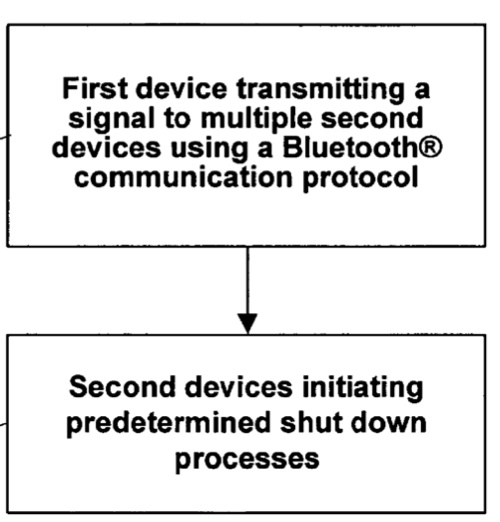According to a new patent (number 20110259840), Apple is looking into a new way to power off Bluetooth-enabled electronic devices, which would let you press just one button on one device to configure or disable multiple devices.
Per the patent, a device can transmit a Bluetooth signal to a linked device to instruct the linked device to power-off. In this manner, the user need only turn off one device manually which results in all linked devices being powered off. This process can be initiated by a user through a device directly linked with the device to be powered-off or through a device that is indirectly connected, through one or more Bluetooth networks, with the device to be powered-off.
This process can also be automatically initiated by a device when a set of predetermined conditions exist. Once instructed to do so, a device can initiate a predetermined power-off process which can involve terminating any ongoing functions and turning off various subsystems. In accordance with the present invention, a user can initiate a power-off of all the devices on a Bluetooth network through a single device. The inventors are Michael M. Lee, Jeffrey J. Terlizzi and Christopher D. Mckiliop.
Here’s Apple’s background and summary of the invention: “The present invention relates to circuitry for powering-off electronic devices. More particularly, the present invention relates to circuitry that allows one electronic device to initiate a power-off process in another electronic device.
“Cost, comfort, and simplicity of operation are important factors in many consumer electronics. Bluetooth devices, especially Bluetooth phone headsets, are an example of useful devices that are often burdened by a relatively large size and overly complicated operation. Bluetooth devices typically include buttons and other controls that, while providing functionality, make use complicated and drive up the cost and weight of the device. For example, Bluetooth headsets might have individual controls for answering and terminating calls, controlling volume, and powering on/off. In the case of Bluetooth headsets, which typically mount onto a user’s ear, the added weight and size from these controls might lead to a less comfortable fit.
“Another common problem with these devices is related to battery life. Even after a user has completed a call, the user often forgets to turn off the device. For this reason, many devices typically include things such as timing circuits that power the device off if it hasn’t been used for a given amount of time. The problem with that ‘solution,’ however, is that it still wastes battery power even though the device is not in use.
“Another problem with these types of devices is related to air travel. In many instances, airport security requires electronic devices to be powered on individually. Similarly, flight attendants often demand that all electronic devices be shut off prior to take off or landing. These situations often require a user to turn off multiple different devices and can lead to devices being dropped and potential damage.
“Methods and systems for powering-off a Bluetooth device from a linked device are provided. A device can transmit a Bluetooth signal to a linked device to instruct the linked device to power-off. In this manner, the user need only turn off one device manually which results in all linked devices being powered off. This process can be initiated by a user through a device directly linked with the device to be powered-off or through a device that is indirectly connected, through one or more Bluetooth networks, with the device to be powered-off.
“This process can also be automatically initiated by a device when a set of predetermined conditions exist. Once instructed to do so, a device can initiate a predetermined power-off process which can involve terminating any ongoing functions and turning off various subsystems. In accordance with the present invention, a user can initiate a power-off of all the devices on a Bluetooth network through a single device.
“In another embodiment, a Bluetooth device can transmit a signal to a linked device which instructs the linked device to switch to a power-saving mode. This predetermined power-saving mode can define the device’s Bluetooth communications and other functions. For example, when instructed by another device, a linked device can restrict its Bluetooth communications to minimal activity and configure other subsystems for power conservation.”
— Dennis Sellers

